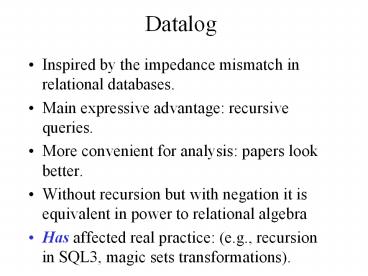Datalog - PowerPoint PPT Presentation
Title:
Datalog
Description:
Datalog Inspired by the impedance mismatch in relational databases. Main expressive advantage: recursive queries. More convenient for analysis: papers look better. – PowerPoint PPT presentation
Number of Views:109
Avg rating:3.0/5.0
Title: Datalog
1
Datalog
- Inspired by the impedance mismatch in relational
databases. - Main expressive advantage recursive queries.
- More convenient for analysis papers look better.
- Without recursion but with negation it is
equivalent in power to relational algebra - Has affected real practice (e.g., recursion in
SQL3, magic sets transformations).
2
Datalog Concepts
- Atoms
- Datalog rules, datalog programs
- EDB predicates, IDB predicates
- Conjunctive queries
- Recursion
- Built-in predicates
- Negated atoms, stratified programs.
- Semantics least fixpoint.
3
Predicates and Atoms
- Relations are represented by predicates -
Tuples are represented by atoms. Purchase(
joe, bob, Nike Town, Nike Air, 2/2/98)
- arithmetic, built-in, atoms X lt 100,
XY5 gt Z/2 - negated atoms
NOT Product(Brooklyn Bridge, 100, Microsoft)
4
Datalog Rules and Queries
- A pure datalog rule has the following form
- head - atom1, atom2, ., atom,
- where all the atoms are non-negated and
relational. - BritishProduct(X) - Product(X,Y,P) Company(P,
UK, SP) - A datalog program is a set of datalog rules.
- A program with a single rule is a conjunctive
query. - We distinguish EDB predicates and IDB predicates
- EDBs are stored in the database, appear only
in the bodies - IDBs are intensionally defined, appear in both
bodies and heads.
5
The Meaning of Datalog Rules
Start with the facts in the EDB and iteratively
derive facts for IDBs.
Repeat the following until you cannot derive any
new facts
Consider every assignment from the variables in
the body to the constants in the database. If
each of the atoms in the body is made true by the
assignment, then add the tuple for the head
into the relation of the head.
6
Transitive Closure
Suppose we are representing a graph by a relation
Edge(X,Y) Edge(a,b), Edge (a,c), Edge(b,d),
Edge(c,d), Edge(d,e)
b
a
d
e
c
I want to express the query Find all nodes
reachable from a.
7
Recursion in Datalog
Path( X, Y ) - Edge( X, Y ) Path( X, Y )
- Path( X, Z ), Path( Z, Y ). Semantics
evaluate the rules until a fixedpoint Iteration
0 Edge (a,b), (a,c), (b,d), (c,d), (d,e)
Path Iteration 1
Path (a,b), (a,c), (b,d), (c,d),
(d,e) Iteration 2 Path gets the new tuples
(a,d), (b,e),
(c,e) Iteration 3 Path gets the new tuple
(a,e) Iteration 4 Nothing
changes -gt We stop. Note number of iterations
depends on the data. Cannot be
anticipated by only looking at the query!
8
Built in Predicates
Rules may include atoms with built-in
predicates ExpensiveProduct(X) -
Product(X,Y,P) P gt 100 But we need to
restrict the use of built-in atoms in
rules. P(X) - R(X) XltY What does this
mean? We could use active domain semantics, but
thats problematic. Hence, we require that every
variable that appears in a built-in atom also
appears in a relational atom.
9
Negated Subgoals
Rules may include negated subgoals, but in
restricted forms P(X,Y) - Between(X,Y,Z)
NOT Direct(X,Z) Bad P(X, Y) - R(X) NOT
S(Y) Bad but ok P(X) - R(X) NOT
S(X,Y) Well rewrite as S(X) - S(X,Y)
P(X) - R(X) NOT S(X)
10
Stratified Rules
A predicate P depends on a predicate Q if Q
appears negated in a rule defining P. If there
is a cycle in the dependency graph, the datalog
program is not stratified. Example p(X) -
r(X) NOT q(X) q(X) - r(X) NOT
p(X) Suppose r has the tuple 1.
11
Subtleties with Stratified Rules
Example p(X) - r(X) q(X) - s(X) NOT
p(X). Suppose R 1, and S 1,2 One
solution P 1 and Q 2 Another
solution P1,2 and Q. Perfect model
semantics apply the rules stratum after stratum.


























![CSCE 580 Artificial Intelligence Ch.12 [P]: Individuals and Relations Datalog PowerPoint PPT Presentation](https://s3.amazonaws.com/images.powershow.com/A1262288656FHmfX.th0.jpg?_=201410050611)




